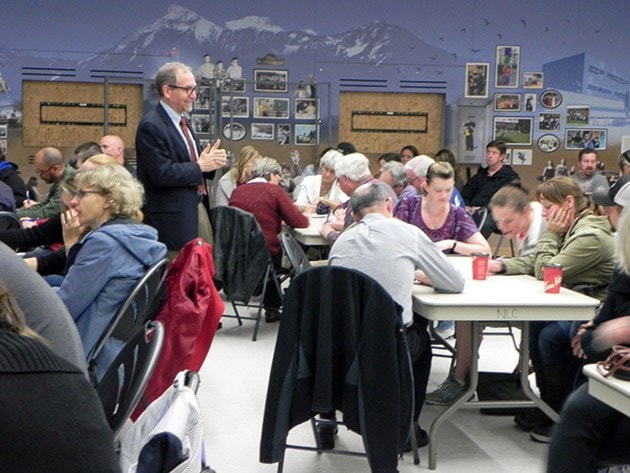Parents had their first chance to publicly speak up about a possible change to the Chilliwack school system Monday night.
The school district is looking seriously into what a new grade configuration would look like. Currently schools are divided from Kindergarten to Grade 6, Grades 7 through 9, and 10 through 12.
A reconfiguration would the shorten elementary school experience, ending at Grade 5. Middle school would include grades 6 though 8, and high school would begin at Grade 9.
Superintendent Evelyn Novak underlined that they haven’t decided whether or not to move ahead with the change, but they have hired a consultation firm to explore the idea. She said it’s not impossible to imagine having a reconfiguration in place as early as September 2017.
“This is a big change and it would take some time,” she said, adding nothing is impossible.
PCG Education moderated most of the meeting on Monday night, held at Chilliwack secondary’s Alumni Hall. (A second public meeting took place at Sardis secondary on Tuesday night). They prompted the crowd to think equally of opportunities and obstacles regarding the potential change. Parents, teachers, administrators, trustees, staff, and even one student, filled the hall.
There were mixed feelings, with some in favour of certain points but strongly against others.
However, points for or against the reconfiguration won’t end up being the deciding factor in whether the school district moves ahead with the reconfiguration. As PCG’s Stephen Kutno noted, the observations and questions posed by these consultation meetings will help build a framework if the plan does move ahead.
“Opportunities are not a reason to do something, and obstacles are not a reason to not do something,” he explained.
Still, the public’s opinion is being weighted on the matter. PCG also met separately with other interest groups through the early week, including staff, teachers, administrators and CUPE members.
A report from all of the meetings will be presented to the board, and available in public format. That could happen sometime in January or February, Kutno said.
While the focus of the meeting as directly on the effect on students, many at the meeting questioned more substantial aspects of the change.
Questions posed to the moderators included: How much will it cost? How exactly will it help overcrowding? How would facilities be changed? Where would the current Grade 6 teachers go?
None of those questions were answered, as it’s too early in the process to do so.
“We are about to climb Mt. Everest and we are still standing at the bottom looking up,” Kutno said. “We can’t answer operational questions yet.”
CSS humanities teacher Steve Anderson voiced several concerns with how reconfiguration would look at the high school level, pointing out that Grade 9 students aren’t ready for the rigours of high school.
Others worried about kids that would fall through the cracks in the transition year, including French immersion students, and those who have their school path laid out at schools of choice or academies.
One of the reasons for considering a change, Novak noted, was due to the new curriculum. Grade 6 lesson plans are now to include more hands-on learning, including subjects like foods and woodworking. Most elementary schools aren’t equipped for those subjects, while middle schools are.
One parent said that several parents she spoke with didn’t understand the notice about the reconfiguration, which didn’t mention clearly that grades could move to different schools. She noted that the turnout may have been even better if that information was made clearer by the district.
Guests were invited to leave behind their questions, obstacles and opportunities on index cards, with their emails attached if they wished to hear back.
What do you think? Email your letters to editor@theprogress.com.
